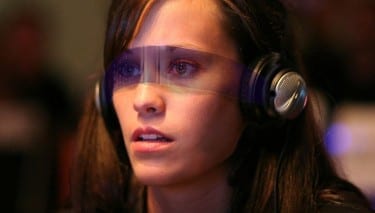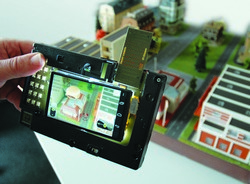
Augmented reality is the enhancement of human perception through overlaying technologies that can expand, annotate and even record the user’s moment-to-moment experience.
Those designing coming augmented reality systems should make them adaptable to change, resistant to hacking and responsive to the needs of diverse users, according to a white paper by an interdisciplinary group of researchers at the University of Washington’s Tech Policy Lab.
Though still in its relative infancy, augmented reality promises systems that can aid people with mobility or other limitations, providing real-time information about their immediate environment as well as hands-free obstacle avoidance, language translation, instruction and much more. From enhanced eyewear like Google Glass to Microsoft’s wearable HoloLens system, tech, gaming and advertisement industries are already investing in and deploying augmented reality devices and systems.
But augmented reality will also bring challenges for law, public policy and privacy, especially pertaining to how information is collected and displayed. Issues regarding surveillance and privacy, free speech, safety, intellectual property and distraction — as well as potential discrimination — are bound to follow.
The Tech Policy Lab brings together faculty and students from the School of Law, Information School and Computer Science & Engineering Department and other campus units to think through issues of technology policy. “Augmented Reality: A Technology and Policy Primer” is the lab’s first official white paper aimed at a policy audience. The paper is based in part on research presented at the 2015 International Joint Conference on Pervasive and Ubiquitous Computing, or UbiComp conference.
Ryan Calo, assistant professor of law and Tech Policy Lab co-director, is lead author together with Batya Friedman of the Information School and Tadayoshi Kohno and Franziska Roesnerof computer science and engineering. Other co-authors are Emily McReynolds, UW Tech Policy Lab associate director; Tamara Denning, who graduated from the UW in computer science and engineering and is now an assistant professor at the University of Utah; Bryce Newell, who graduated from the UW Information School and is now a postdoctoral researcher the University of Tilburg; Information School doctoral student Lassana Magassa and School of Law alumnus Jesse Woo.
The researchers used a method of work designed by the Tech Policy Lab for evaluating new technologies, first conferring with those in the computer science field to define augmented reality as precisely as possible. Then they look to the humanities and social sciences — information science, in this case — to consider the impact of the technology in question on various end users. They called these “diversity panels.”
Magassa, who organized the diversity panels, said they help to ensure that underrepresented groups are highlighted in a way that makes sense to those that develop technology and its governing policies.
“They also are important in that they increase the likelihood that the people who develop such policies get to hear and consider alternate points of view, concerns and visions as they design and develop technology policies,” he said.
The researchers sorted issues raised by augmented reality into basic categories: those relating to the collection of information, and those relating to its display.
- The collection of information raises issues that include a reasonable expectation of privacy, the First Amendment right to free speech, intellectual property and the relaying of information to third parties.
- The display of information in augmented reality systems prompted questions about harm caused by errors or negligence, product liability and potential discrimination or even digital assault.
The group arrived at a set of recommendations for policymakers that “do not purport to advance any particular vision, but rather provide guidance that can be used to inform the policymaking process.”
Their recommendations, briefly put, were:
Read more: Life, enhanced: UW professors study legal, social complexities of an augmented reality future
The Latest on: Augmented Reality
[google_news title=”” keyword=”Augmented Reality” num_posts=”10″ blurb_length=”0″ show_thumb=”left”]
via Google News
The Latest on: Augmented Reality
- Virtual reality could make seeing your favorite band less expensive, if these artists have their wayon April 27, 2024 at 6:06 am
Heavy-metal band Avenged Sevenfold and rapper T-Pain are among a growing number of artists who are using virtual reality to connect with their fans at a ...
- Augmented reality creation platform Trace launches with $2Mon April 25, 2024 at 10:09 am
Trace, a location-based augmented reality creation platform, today announced its launch with $2 million in funds led by Rev1 Ventures and Impellent Ventures to make it simple for businesses to bring ...
- Swave Photonics debuts Holographic eXtended Reality display with tiny-pixel technologyon April 25, 2024 at 6:00 am
Holographic display startup Swave Photonics today announced the development of what is claimed to be the world’s first 3D holographic display technology for compact extended reality form factors such ...
- Amare takes flight: Brussels Airlines and Tomorrowland unveil augmented reality livery on new Airbus A320neo0on April 25, 2024 at 5:52 am
Brussels Airlines and Tomorrowland debut "Amare," a new Belgian Icon symbolising unity and the fusion of the music festival and airline brands. The Airbus ...
- Doctors use augmented reality in knee replacement surgery. How is it done?on April 24, 2024 at 10:49 pm
A 70-year-old undergoes India's first Kinematic Bilateral Total Knee Replacement surgery using Augmented Reality (AR).
- A New Augmented Reality Project Restores the Third Ward’s Historic ‘Ghost’ Signson April 24, 2024 at 1:15 pm
Augmented History’ – created by Hoffman York – digitally recreates the fading signs on the side of buildings – and you can see them through your phone.
- Can Augmented Reality Be the Future of Cybersecurity?on April 24, 2024 at 3:32 am
The post Can Augmented Reality Be the Future of Cybersecurity? first appeared on IT News Africa | Business Technology, Telecoms and Startup News.
- Virtual Reality Newson April 20, 2024 at 5:00 pm
360-Degree Head-Up Display View Could Warn Drivers of Road Obstacles in Real Time Dec. 21, 2023 — Researchers have developed an augmented reality head-up display that could improve road safety ...
- Augmented Reality Revolutionizing Remote Supporton April 19, 2024 at 4:43 am
Augmented Reality (AR) is transforming remote support and specialized fields in the business world, driving efficiency, collaboration, and innovation. Explore the projected growth of India's AR and VR ...
- Is Augmented Reality Set to Transform Card Games?on April 15, 2024 at 9:05 pm
With major advances in AR over the last few years, it looks set to be mainstream before 2030. This could be a game-changer for card games, which would benefit greatly from new AR elements. These could ...
via Bing News










